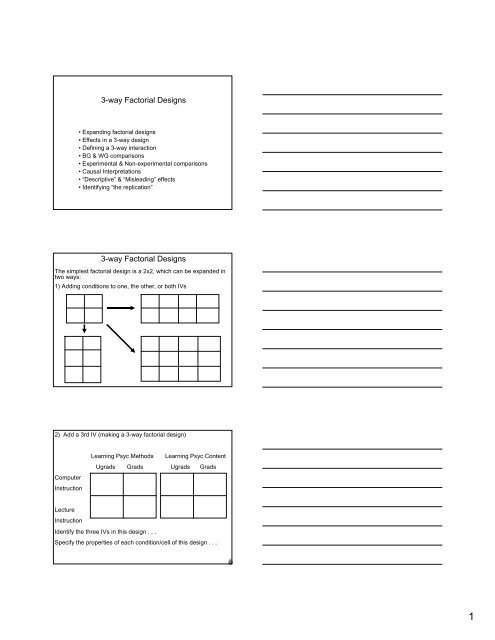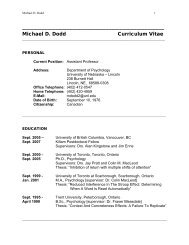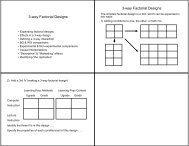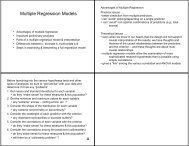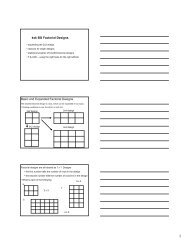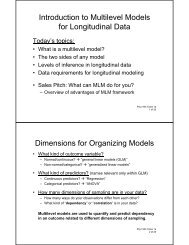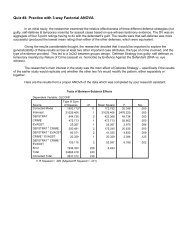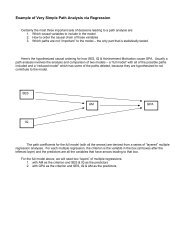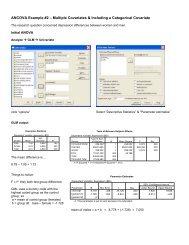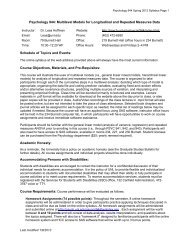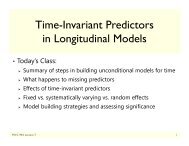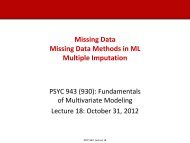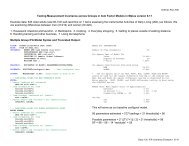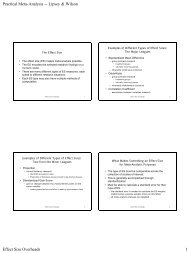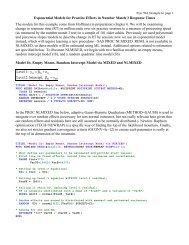3-way Factorial Designs 3-way Factorial Designs
3-way Factorial Designs 3-way Factorial Designs
3-way Factorial Designs 3-way Factorial Designs
Create successful ePaper yourself
Turn your PDF publications into a flip-book with our unique Google optimized e-Paper software.
3-<strong>way</strong> <strong>Factorial</strong> <strong>Designs</strong><br />
• Expanding factorial designs<br />
• Effects in a 3-<strong>way</strong> design<br />
• Defining a 3-<strong>way</strong> interaction<br />
•BG & WG comparisons<br />
• Experimental & Non-experimental comparisons<br />
• Causal Interpretations<br />
• “Descriptive” & “Misleading” effects<br />
• Identifying “the replication”<br />
3-<strong>way</strong> <strong>Factorial</strong> <strong>Designs</strong><br />
The simplest factorial design is a 2x2, which can be expanded in<br />
two <strong>way</strong>s:<br />
1) Adding conditions to one, the other, or both IVs<br />
2) Add a 3rd IV (making a 3-<strong>way</strong> factorial design)<br />
Computer<br />
Instruction<br />
Learning Psyc Methods Learning Psyc Content<br />
Ugrads Grads Ugrads Grads<br />
Lecture<br />
Instruction<br />
Identify the three IVs in this design . . .<br />
Specify the properties of each condition/cell of this design . . .<br />
1
3-Way <strong>Factorial</strong> <strong>Designs</strong><br />
There are 7 effects involved in a 3-<strong>way</strong> factorial<br />
• 3 main effects (one for each IV)<br />
• 3 2-<strong>way</strong> interactions (one for each pair of IVs)<br />
•13-<strong>way</strong> interaction<br />
For the example name the ...<br />
• main effects<br />
1. Topic 2. Instruction Method 3. Ed. level<br />
• 2-<strong>way</strong> interactions<br />
1. Topic X Inst. Method 2 .Topic X Ed. Level<br />
3. Inst. Method X Ed. Level<br />
• 3-<strong>way</strong> interaction Topic X Instruction Method X Ed. level<br />
What does a 3-<strong>way</strong> interaction look<br />
like?<br />
• Remember that a 2-<strong>way</strong> interaction is,<br />
“when the effect of one IV is different<br />
for different levels of a 2nd IV”<br />
• Extending this to a design with 3 IVs, a<br />
3-<strong>way</strong> interaction is, “when the<br />
interaction of two IVs is different for<br />
different levels of a 3rd IV”<br />
Practice<br />
Difficulty 1 10<br />
Easy 70 90<br />
Hard 20 70<br />
SE of Practice is different<br />
for Easy and Hard Tasks<br />
Familiar Task<br />
Practice<br />
Difficulty 1 10<br />
Easy 50 90<br />
Hard 25 60<br />
Unfamiliar Task<br />
Practice<br />
Difficulty 1 10<br />
Easy 90 90<br />
Hard 15 80<br />
The 2-<strong>way</strong> interaction of<br />
Practice and Difficulty is<br />
different for Familiar and<br />
Unfamiliar Tasks<br />
Considering BG and WG comparisons…<br />
… there are four different kinds of 3-<strong>way</strong> designs.<br />
Completely Between Groups 3-<strong>way</strong><br />
Completely Within-Groups 3-<strong>way</strong> (each either<br />
repeated measures of matched-groups)<br />
Mixed 3-<strong>way</strong> with 2 BG and 1 WG (either<br />
repeated measures of matched-groups)<br />
Mixed 3-<strong>way</strong> with 1 BG and 2 WG (each either<br />
repeated measures of matched-groups)<br />
2
Considering Experimental & Nonexperimental comparisons …<br />
… there are four different kinds of 3-<strong>way</strong> designs.<br />
All 3 IVs are RA & Manip, etc.<br />
All 3 “IVs” are measured (subject) variables<br />
1 IV is RA & Manip, etc. -- other two “IVs” are<br />
measured (subject) variables<br />
2 IVs are RA & Manip, etc. -- other “IV” is a<br />
measured (subject) variables<br />
Causal Interpretations of 3-<strong>way</strong> <strong>Designs</strong><br />
• When can a main effect be causally interpreted ?<br />
When the conditions of that IV are RA, Manip, Etc.<br />
• When can a 2-<strong>way</strong> interaction be causally interpreted ?<br />
When the conditions of both the<br />
involved IVs are RA, Manip, Etc.<br />
• When can a 3-<strong>way</strong> interaction be causally interpreted ?<br />
When the conditions of all three IVs<br />
are RA, Manip, Etc.<br />
“Descriptive” effects in a 3-<strong>way</strong><br />
The 3-<strong>way</strong> -- significant or not -- is al<strong>way</strong>s descriptive !<br />
If the 3-<strong>way</strong> is significant, all 2-<strong>way</strong> & main effects are “suspect”<br />
If the 3-<strong>way</strong> is significant, a 2-<strong>way</strong> is only descriptive if that 2-<strong>way</strong><br />
has the same pattern for each condition of the 3 rd IV<br />
If the 3-<strong>way</strong> is significant, a main effect is only descriptive if that<br />
main effect has the same pattern for each combination of the<br />
other two IVs<br />
If the 3-<strong>way</strong> is non-significant, all three 2-<strong>way</strong>s are significant<br />
3
“Descriptive” effects in a 3-<strong>way</strong><br />
If a 2-<strong>way</strong> is significant, the main effects of those IVs are “suspect”<br />
If a 2-<strong>way</strong> is significant, the main effect of an IV involved in that<br />
interaction is only descriptive if that main effect has the same<br />
pattern for each condition of the other IV<br />
The main effect of an IV that is not involved in any 2-<strong>way</strong> or<br />
3-<strong>way</strong> interaction is al<strong>way</strong>s descriptive<br />
Identifying “the replication”<br />
With 7 main effects and interactions (and myriad simple effects)<br />
you have to be careful to get the correct part of the design that is<br />
“the replication” of an earlier study.<br />
Example: You want to check if your recent 3-<strong>way</strong> study replicated<br />
an earlier effect that people who had 10 practices did about 40<br />
points better than those who had only one practice (same DV).<br />
As you can see,<br />
there is much<br />
variability in the<br />
effect of practice --<br />
depending upon the<br />
conditions of the<br />
other IVs<br />
Familiar Task<br />
Practice<br />
Difficulty 1 10<br />
Easy 50 90<br />
Hard 25 60<br />
Unfamiliar Task<br />
Practice<br />
Difficulty 1 10<br />
Easy 90 90<br />
Hard 15 80<br />
4


